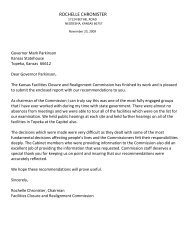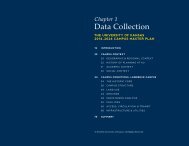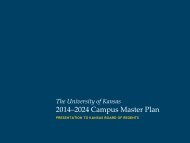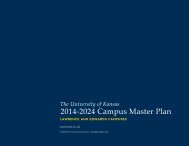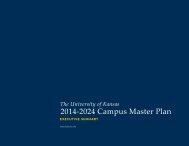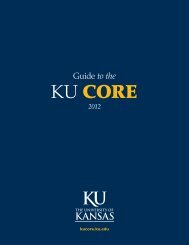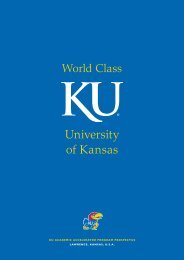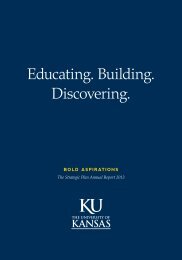Bold Aspirations, Year 1 Annual Report
Fall 2012 Annual Report for Bold Aspirations, the five-year strategic plan for the University of Kansas.
Fall 2012 Annual Report for Bold Aspirations, the five-year strategic plan for the University of Kansas.
You also want an ePaper? Increase the reach of your titles
YUMPU automatically turns print PDFs into web optimized ePapers that Google loves.
BOLD ASPIRATIONS<br />
ANNUAL REPORT<br />
Fall 2012
MESSAGE FROM THE PROVOST<br />
The mission of the University of Kansas is to lift students and society by<br />
educating leaders, building healthy communities, and making discoveries that<br />
will change the world.<br />
KU’s vision is to be recognized as a top-tier public international research<br />
institution. This past year the KU community moved closer to that vision by<br />
implementing <strong>Bold</strong> <strong>Aspirations</strong>, our strategic plan for 2012-17.<br />
We have made tremendous progress toward our goals through the efforts of<br />
hundreds of faculty, staff, and students serving on committees; working on<br />
specific projects; providing candid and thoughtful feedback via surveys, town<br />
halls, and summits; and talking with one another about our bold aspirations.<br />
The success of our transformation relies on the continued input and engagement<br />
of the entire community.<br />
<strong>Bold</strong> <strong>Aspirations</strong> is the template for our transformation and my utmost<br />
priority. Over the five years of implementation, the team I appointed to ensure<br />
that transformation will provide annual updates on our progress. I hope this first<br />
report — covering the period from the start of implementation in mid-September<br />
2011 through June 2012 — allows students, faculty, staff, alumni, and other<br />
stakeholders to recognize our initial successes and inspires us to keep striving<br />
to raise the expectations we have for ourselves, the aspirations we have for our<br />
state, and the hopes we have for our world.<br />
Jeffrey S. Vitter<br />
Provost and Executive Vice Chancellor<br />
BOLD ASPIRATIONS ANNUAL REPORT FALL 2012 | 3
BOLD ASPIRATIONS STRATEGIC PLAN<br />
GOAL 1 GOAL 2 GOAL 3 GOAL 4 GOAL 5 GOAL 6<br />
Strengthen<br />
recruitment,<br />
teaching, and<br />
mentoring<br />
to prepare<br />
undergraduate<br />
students<br />
for lifelong<br />
learning,<br />
leadership, and<br />
success<br />
Prepare<br />
doctoral<br />
students as<br />
innovators<br />
and leaders<br />
who are ready<br />
to meet the<br />
demands of<br />
the academy<br />
and our global<br />
society<br />
Enhance<br />
research<br />
broadly<br />
with special<br />
emphasis<br />
upon areas of<br />
present and<br />
emerging<br />
strength in<br />
order to push<br />
the boundaries<br />
of knowledge<br />
and benefit<br />
society<br />
Engage local,<br />
state, national,<br />
and global<br />
communities<br />
as partners<br />
in scholarly<br />
activities that<br />
have direct<br />
public impact<br />
Recruit, value,<br />
develop, and<br />
retain an<br />
excellent and<br />
diverse faculty<br />
and staff<br />
Responsibly<br />
steward fiscal<br />
and physical<br />
resources<br />
and energize<br />
supporters to<br />
expand the<br />
resource base<br />
STRATEGY STRATEGY STRATEGY STRATEGY STRATEGY STRATEGY<br />
Establish a<br />
new KU core<br />
curriculum<br />
for all<br />
undergraduate<br />
students<br />
(1-A)<br />
Develop<br />
sustainable<br />
funding for<br />
doctoral<br />
education<br />
(2-A)<br />
Pursue<br />
multidisciplinary<br />
strategic<br />
initiatives<br />
(3-A)<br />
Promote a<br />
culture that<br />
openly values<br />
engaged<br />
scholarship<br />
(4-A)<br />
Enhance the<br />
recruitment<br />
process for<br />
excellence in<br />
hiring<br />
(5-A)<br />
Reallocate<br />
resources on a<br />
regular basis to<br />
priorities<br />
(6-A)<br />
Strengthen<br />
the pipeline of<br />
undergraduates<br />
to and through<br />
KU<br />
(1-B)<br />
Invest in firstyear<br />
intellectual<br />
experiences<br />
(1-C)<br />
Enhance<br />
experiential<br />
learning<br />
opportunities<br />
(1-D)<br />
Redesign<br />
courses to<br />
enhance student<br />
learning<br />
(1-E)<br />
Use<br />
comparative<br />
data to set<br />
academic<br />
program<br />
standards<br />
(2-B)<br />
Develop a<br />
comprehensive<br />
doctoral student<br />
recruitment<br />
plan<br />
(2-C)<br />
Size academic<br />
programs based<br />
upon merit,<br />
mentoring, and<br />
placement<br />
(2-D)<br />
Increase<br />
research<br />
activities,<br />
innovation, and<br />
funding<br />
(3-B)<br />
Document<br />
research<br />
excellence<br />
with enhanced<br />
accountability<br />
(3-C)<br />
Encourage,<br />
support, and<br />
coordinate<br />
engaged<br />
scholarship<br />
(4-B)<br />
Promote active<br />
entrepreneurship<br />
and vibrant<br />
external<br />
partnerships<br />
(4-C)<br />
Develop and<br />
retain talent and<br />
leadership at all<br />
levels to thrive<br />
in an era of<br />
change<br />
(5-B)<br />
Be accountable<br />
(5-C)<br />
Enhance<br />
diversity of<br />
faculty, staff, and<br />
students<br />
(5-D)<br />
Create a<br />
comprehensive<br />
process for<br />
facilities planning<br />
(6-B)<br />
Energize Far<br />
Above, the<br />
comprehensive<br />
fundraising<br />
campaign<br />
(6-C)<br />
4 | BOLD ASPIRATIONS ANNUAL REPORT FALL 2012
INTRODUCTION FROM THE<br />
IMPLEMENTATION TEAM<br />
<strong>Bold</strong> <strong>Aspirations</strong> comprises six goals and 22<br />
individual strategies to target specific areas<br />
where we can improve and where our efforts<br />
will have the most benefit. Once accomplished,<br />
the goals will position KU to realize its vision.<br />
We are measuring progress across the goals<br />
using specific metrics. Briefly, the goals are<br />
1. Strengthen recruitment, teaching,<br />
and mentoring<br />
2. P repare doctoral students to be innovators<br />
and leaders<br />
3. E nhance research to push the boundaries<br />
of knowledge and benefit society<br />
4. E ngage local, state, national,<br />
and international communities as<br />
scholarly partners<br />
5. R ecruit and retain excellent faculty<br />
and staff<br />
6. R esponsibly steward all resources<br />
These goals will enrich and strengthen<br />
the four strategic initiative themes that define<br />
KU’s highest priorities for research investment<br />
over the next five years:<br />
Sustaining the Planet, Powering the World<br />
Promoting Well-Being, Finding Cures<br />
Building Communities, Expanding<br />
Opportunities<br />
Harnessing Information, Multiplying<br />
Knowledge<br />
The key to <strong>Bold</strong> <strong>Aspirations</strong> is its focus. In<br />
creating our strategic plan, the university<br />
community understood it could not do<br />
everything at once.<br />
We chose five areas of focus for the first year of<br />
implementation and have highlighted them in<br />
this Fall 2012 <strong>Annual</strong> <strong>Report</strong>:<br />
Strategy 1-A Establish a new KU Core<br />
curriculum for all undergraduates<br />
Strategy 1-B Strengthen the pipeline of<br />
undergraduates to and through KU<br />
Strategy 1-C Invest in first-year intellectual<br />
experiences<br />
Strategy 2-A Develop sustainable funding<br />
for doctoral education<br />
Strategy 3-A Pursue multidisciplinary<br />
strategic initiatives<br />
This report also details how we are moving<br />
forward across all six goals in large and small<br />
ways and previews the areas of focus for <strong>Year</strong> 2<br />
of implementation.<br />
Implementation Team<br />
Danny J. Anderson College dean’s office<br />
Kristin Bowman-James Chemistry<br />
department<br />
Heather Eastlund Provost’s office (staff)<br />
Diane Goddard Provost’s office<br />
Chris Haufler Provost’s office<br />
Mary Lee Hummert Provost’s office<br />
Sara Rosen Provost’s office (chair)<br />
Deb Teeter Institutional Research &<br />
Planning<br />
Steve Warren Research & Graduate<br />
Studies<br />
Andi Witczak Center for Service Learning<br />
Gavin Young Public Affairs<br />
boldaspirations.ku.edu<br />
provost.ku.edu/strategic-plan<br />
BOLD ASPIRATIONS ANNUAL REPORT FALL 2012 | 5
Transforming<br />
our university:<br />
Major<br />
Accomplishments<br />
of <strong>Year</strong> 1
Goal 1 Strengthen recruitment, teaching, and mentoring to prepare undergraduate<br />
students for lifelong learning, leadership, and success<br />
Strategy 1-A:<br />
Establish a new KU core curriculum for all undergraduate students<br />
Actions completed<br />
Develop the foundation for a new<br />
undergraduate core curriculum with<br />
clear educational goals and learning<br />
outcomes<br />
Actions in progress<br />
Design and implement a new<br />
undergraduate core curriculum<br />
Pilot student use of e-portfolios to<br />
provide evidence of achievement of<br />
learning outcomes<br />
Planning for a university-wide undergraduate<br />
core curriculum has continued since Chancellor<br />
Bernadette Gray-Little’s task force on retention<br />
and graduation first met in November 2009,<br />
led by Professor Chris Haufler, chair of ecology<br />
and evolutionary biology. It accelerated with<br />
the launch of the strategic planning process in<br />
October 2010. The work group on energizing<br />
the educational environment, also chaired<br />
by Haufler, developed the six goals of the KU<br />
Core, based on the hard work and direct input<br />
of more than 1,000 faculty, staff, and students.<br />
KU will launch the KU Core in fall 2013. All<br />
undergraduate students must complete 12 units<br />
within the curriculum.<br />
Developing Learning Outcomes: Six<br />
Satellite Committees<br />
Six satellite committees developed learning<br />
outcomes specific to their assigned educational<br />
goal, describing the skills or competencies<br />
students must demonstrate to achieve each goal.<br />
The committees also generated specific learning<br />
activities for each outcome and developed<br />
metrics to assess evidence of student learning.<br />
8 | BOLD ASPIRATIONS ANNUAL REPORT FALL 2012
Transforming Planning Into the KU Core:<br />
Transition Committee<br />
The KU Core Transition Committee finalized<br />
learning outcomes, set requirements for<br />
fulfilling each goal, and established the process<br />
for nominating courses and educational<br />
experiences.<br />
Two surveys were distributed to faculty, staff,<br />
and students; more than 1,600 individuals<br />
responded to at least one of them. In May, the<br />
committee hosted a town hall as an opportunity<br />
to discuss the goals, learning outcomes, and<br />
requirements for fulfilling the KU Core.<br />
Implementing the KU Core<br />
The policy establishing the University Core<br />
Curriculum Committee (UCCC) was presented<br />
to the Faculty Executive Committee, Faculty<br />
Senate, and deans and approved by the provost<br />
in June 2012.<br />
The UCCC will adopt courses and educational<br />
experiences for the KU Core and will oversee<br />
policy and process related to it.<br />
Voting members include an elected faculty<br />
representative from each of the five College<br />
divisions and each professional school with an<br />
undergraduate program (13 members serving<br />
three-year terms) and three students (one-year<br />
terms). Representatives from the KU Libraries,<br />
the schools of Nursing and Health Professions,<br />
and Undergraduate Studies will be ex officio,<br />
non-voting members. The chair will be elected<br />
annually by the committee.<br />
The KU Core Nomination Process<br />
To School/College for approval<br />
Certain courses that easily meet one of the<br />
learning outcomes will receive “fast-track”<br />
approval, with full approval required in the first<br />
two years of launching the KU Core. All courses<br />
and educational experiences in the KU Core<br />
will go through a periodic reapproval process to<br />
ensure they continue to meet the outcomes of<br />
the KU Core.<br />
kucore.ku.edu<br />
Professor completes form<br />
To department for approval<br />
Department OKs<br />
School/College OKs,<br />
sends to UCCC for final approval<br />
UCCC OKs<br />
To UCCC as advance notice<br />
of a nomination<br />
Course becomes a CORE course<br />
The 2011-12 six-year graduation rate is 60.7 percent.<br />
Our 10-year goal is 70 percent.<br />
BOLD ASPIRATIONS ANNUAL REPORT FALL 2012 | 9
Goal 1 Strengthen recruitment, teaching, and mentoring to prepare undergraduate<br />
students for lifelong learning, leadership, and success<br />
Strategy 1-B:<br />
Strengthen the pipeline of undergraduates to and through KU<br />
Actions completed<br />
Reorganize recruiting by focusing<br />
on communication and a new<br />
comprehensive scholarship plan based<br />
on renewable four-year scholarships<br />
Actions in progress<br />
Strengthen partnerships with<br />
community colleges to facilitate<br />
student transfer to KU<br />
Initiate a central academic unit to<br />
enhance undergraduate advising<br />
Adopt policies and procedures to<br />
ensure that students make timely,<br />
achievable major choices<br />
To keep KU at the forefront of undergraduate<br />
education, the university must improve how it<br />
recruits, aids, and prepares student scholars.<br />
Once students are enrolled, the university<br />
must provide the necessary support to ensure<br />
they remain at KU pursuing their degrees and<br />
graduate within six years.<br />
Raising the Bar: Chancellor Sets Goals for<br />
Undergraduate Pipeline<br />
Chancellor Gray-Little set targets related to<br />
strategy 1-B. In the next 10 years, KU aspires to<br />
Raise its freshman retention rate to 90<br />
percent (currently 79.9 percent)<br />
Raise its six-year graduation rate to 70<br />
percent (currently 60.7 percent)<br />
On each metric, KU ranks below its peers.<br />
By meeting each target, KU will be better<br />
positioned to meet its vision of recognition<br />
among the top tier of the nation’s best public<br />
international research universities.<br />
The process of raising retention and graduation<br />
rates has begun. New recruitment and<br />
orientation strategies are in effect, and a<br />
comprehensive scholarship plan that provides<br />
four-year renewable scholarships to every<br />
qualifying freshman started in fall 2012.<br />
10 | BOLD ASPIRATIONS ANNUAL REPORT FALL 2012
Building the KU Brand: Develop<br />
Consistent Recruiting Messages<br />
Marketing Communications, working with<br />
the Office of Admissions, created postcards,<br />
brochures, and catalogs ranging from<br />
first contact with prospective students<br />
to new-student orientation handbooks.<br />
These have consistent messages, tone,<br />
look, and feel. Complementary print and<br />
social media campaigns incorporated new<br />
data development to expand the pool of<br />
prospective students.<br />
admissions.ku.edu<br />
Ensuring Success:<br />
New Admissions Standards<br />
The Board of Regents approved new admissions<br />
standards that will be effective in fall 2016.<br />
These are intended to identify academically<br />
prepared new students who can succeed at a<br />
flagship university.<br />
To be admitted automatically to KU, new<br />
freshmen will need to<br />
Complete the Kansas Qualified Admissions<br />
Precollege Curriculum<br />
Graduate from a high school or<br />
home school<br />
Have a minimum 3.0 high school GPA<br />
combined with a 24 on the ACT (1090 SAT)<br />
or have a minimum 3.25 high school GPA<br />
and a 21 on the ACT (980 SAT).<br />
Ensuring Success: Early Warning System<br />
for Students<br />
A new support system, MySuccess, was<br />
introduced in fall 2012 and will track the<br />
progress of more than 2,900 students in nine<br />
pilot courses, mostly large survey courses<br />
in such subjects as biology, geology, and<br />
psychology. This early warning system will<br />
permit faculty and advisors to quickly identify<br />
students who are having academic difficulties<br />
and refer them to a range of resources such as<br />
tutoring and stress management.<br />
The early warning system will be supported<br />
by the MySuccess Service Catalog, which<br />
provides a comprehensive overview of<br />
resources and services available to faculty<br />
and students. Students will be able to create<br />
a personalized network of support services<br />
as well.<br />
The first-time, full-time<br />
freshman retention rate<br />
is 79.9 percent. Our<br />
10-year goal is 90 percent.<br />
The applications of students who do not meet<br />
the automatic admission criteria will be reviewed<br />
by a committee to consider such factors as<br />
strength of high school course work, grade<br />
trend, academic potential, diversity, family<br />
circumstances, and the student’s ability to benefit<br />
from support services available at the university.<br />
BOLD ASPIRATIONS ANNUAL REPORT FALL 2012 | 11
Goal 1 Strengthen recruitment, teaching, and mentoring to prepare undergraduate<br />
students for lifelong learning, leadership, and success<br />
Strategy 1-C:<br />
Invest in first-year intellectual experiences<br />
Actions completed<br />
Institute a common book program<br />
Develop topical, discussion-based, firstyear<br />
seminars<br />
Actions in progress<br />
Implement block enrollment in the<br />
freshman year to encourage cohorts<br />
and learning communities<br />
A student’s first year sets the tone for the<br />
college experience. Students who engage<br />
intellectually with one another will likely stay<br />
engaged until graduation. Investing in first-year<br />
experiences helps KU retain students and aids<br />
them in building skills needed to earn a degree.<br />
Discover. Engage. Belong. Office of First-<strong>Year</strong><br />
Experience Established<br />
Orientation, Hawk Week, Hawk Days, First-<br />
<strong>Year</strong> Seminars, Living Learning Communities,<br />
and KU Common Book are now part of the<br />
Office of First-<strong>Year</strong> Experience.<br />
KU Common Book: Notes From No<br />
Man’s Land<br />
KU’s first common book — Notes From No<br />
Man’s Land, a collection of essays by Eula<br />
Biss — was selected from more than 125<br />
nominations by faculty, staff, and students.<br />
All incoming students received a copy at<br />
orientation. Fall 2012 activities include small<br />
group discussions, a visit by the author, and<br />
conversations about a Spencer Museum<br />
Common Work of Art. Courses in multiple<br />
disciplines are incorporating the common book.<br />
12 | BOLD ASPIRATIONS ANNUAL REPORT FALL 2012
Promoting Deep Learning:<br />
Pilot First-<strong>Year</strong> Seminars<br />
Incoming freshmen could choose to enroll in<br />
one of 11 first-year seminars offered this fall.<br />
The seminars — built around provocative topics<br />
in science, the humanities, and culture — are<br />
limited to 19 participants each to encourage<br />
discussion and collaboration. All are led by<br />
professors, and all fulfill a general education<br />
principal course requirement. In the future,<br />
the seminars will satisfy at least one KU Core<br />
learning outcome. The 2012 topics:<br />
Biology Why Do the Birds and Bees Do It?<br />
Business Commerce Today: Is This What<br />
Adam Smith Envisioned?<br />
Engineering Innovations in<br />
Bioengineering<br />
Geology Our Future Energy: Myths,<br />
Solutions, and Sustainability<br />
History From the Locomotive to the Smart<br />
Phone: Culture, Space, and Time in the<br />
Machine Age<br />
Journalism Living in a Visual World<br />
Linguistics Beyond English: Is One<br />
Language Enough in Today’s World?<br />
Psychology Remembering Our Past: How<br />
Memory Works and Why It Matters<br />
Public Affairs & Administration Drugs,<br />
Cars, Cops, and Social Justice<br />
Spanish Once Upon a Time … Narrative,<br />
Culture, and Adaptation<br />
Theatre The Seduction of Culture and<br />
What to Do About It<br />
Living Learning Communities and Block<br />
Enrollment: Pilot Project<br />
Studies show that students who live in<br />
learning communities have higher GPAs,<br />
higher persistence to graduation, and higher<br />
satisfaction with their collegiate experience.<br />
KU offered two living learning communities<br />
this fall:<br />
The Mount Oread Scholars program is the<br />
pilot for a living learning community in<br />
the newly remodeled Gertrude Sellards<br />
Pearson Residence Hall. A cohort of 60<br />
students is co-enrolled in a Mount Oread<br />
Scholars seminar and a course fulfilling<br />
a general education requirement. These<br />
students will have recurring opportunities<br />
to connect with fellow scholars, faculty,<br />
advisors, and administrators.<br />
Ten students in the University Honors<br />
Program who are interested in healthrelated<br />
fields are living in Templin<br />
Residence Hall and have enrolled in an<br />
honors seminar and in one-semester<br />
courses around the theme Current Trends<br />
in Health & Health-Related Fields. These<br />
courses fulfill requirements in majors such<br />
as biology or English. The project also<br />
encourages co-curricular activities such<br />
as peer mentorships by honors alumni<br />
enrolled at the KU Medical Center and<br />
study abroad opportunities in Guatemala<br />
and Peru.<br />
honors.ku.edu<br />
advising.ku.edu/programs/oread<br />
BOLD ASPIRATIONS ANNUAL REPORT FALL 2012 | 13
Goal 2 Prepare doctoral students as innovators and leaders who are ready to meet<br />
the demands of the academy and our global society<br />
Strategy 2-A:<br />
Develop sustainable funding for doctoral education<br />
Actions completed<br />
Collect and analyze data about the<br />
level of institutional support for<br />
doctoral education<br />
Actions in progress<br />
Develop flexible funding models and<br />
workloads for graduate assistantships<br />
Increase external and internal funding<br />
opportunities for doctoral education<br />
Make doctoral education a priority<br />
in Far Above, the comprehensive<br />
fundraising campaign<br />
Success in doctoral education defines KU’s<br />
national and worldwide standing as a public<br />
international research institution. Doctoral<br />
students are the innovators of the future.<br />
Raising the Bar: Chancellor Sets Goals for<br />
Graduate Education<br />
In December 2011, Chancellor Gray-Little<br />
outlined goals to increase our ranking among<br />
the 94 public comprehensive doctoral research<br />
universities and to better educate leaders. To<br />
achieve those goals, we aspire to<br />
Reduce the time to degree for doctoral<br />
students, especially focusing on programs<br />
whose median time to degree is greater<br />
than seven years<br />
Elevate our national stature by having 21<br />
graduate degree programs in the top 10<br />
among public universities in the U.S. News<br />
& World <strong>Report</strong> rankings (currently at 15)<br />
Review of Doctoral Funding Landscape<br />
For the first time, KU has made a<br />
comprehensive, university-wide review of how<br />
doctoral education is funded. The Doctoral<br />
Funding Work Group, chaired by Danny J.<br />
Anderson, dean of the College of Liberal Arts &<br />
Sciences, met to re-envision how KU financially<br />
supports its highest degree. Besides gathering<br />
comprehensive data on funding, the work<br />
group reviewed KU’s peers and their models<br />
for funding and for doctoral training through<br />
teaching and research assistantships. A key<br />
consideration was the ideal balance between<br />
teaching and research.<br />
A preliminary report, completed in June<br />
2012, suggests strategies for implementing a<br />
KU-specific model and is being reviewed by<br />
the provost, senior vice provost, and dean of<br />
graduate studies. In order to develop the new<br />
KU model, a committee will be charged with<br />
implementing specific recommendations from<br />
the report.<br />
In 2011-12, 27 percent of<br />
graduate students held<br />
teaching appointments and<br />
15 percent held graduate<br />
research appointments.<br />
Our goal is to increase<br />
research appointments.<br />
14 | BOLD ASPIRATIONS ANNUAL REPORT FALL 2012
BOLD ASPIRATIONS ANNUAL REPORT FALL 2012 | 15
Goal 3 Enhance research broadly with special emphasis upon areas of present and<br />
emerging strength in order to push the boundaries of knowledge and benefit society<br />
Strategy 3-A:<br />
Pursue multidisciplinary strategic initiatives<br />
Actions in progress<br />
Pursue strategic initiatives that position<br />
KU as a national leader<br />
Develop hiring plans involving joint<br />
appointments in support of strategic<br />
initiatives<br />
Of the fall 2012<br />
new faculty hires,<br />
30 are connected with<br />
strategic initiative themes.<br />
KU is investing in four strategic initiative<br />
themes to position faculty and researchers to<br />
make major contributions to society as well as<br />
secure the external funding needed to reach our<br />
full potential:<br />
Sustaining the Planet, Powering the World<br />
Promoting Well-Being, Finding Cures<br />
Building Communities, Expanding<br />
Opportunities<br />
Harnessing Information, Multiplying<br />
Knowledge<br />
Coming Together: Strategic Initiative Summits<br />
Four summits drew more than 900 attendees,<br />
and individual reports were generated for each<br />
theme outlining our biggest opportunities<br />
and honestly assessing our weaknesses to<br />
determine the biggest impact KU can have on<br />
the four strategic initiative themes.<br />
Faculty made new connections and created<br />
exciting opportunities for multidisciplinary<br />
projects.<br />
16 | BOLD ASPIRATIONS ANNUAL REPORT FALL 2012
Targeted Investments: Research Investment<br />
Council and Strategic Initiative Grant Program<br />
Direct investments are now being made in<br />
faculty and researchers’ multidisciplinary<br />
projects that are directly tied to a strategic<br />
initiative theme. The strategic initiative grants<br />
will be awarded to faculty for projects ranging<br />
from seed funding of initial efforts to major<br />
financial support of large multidisciplinary<br />
research proposals.<br />
The Research Investment Council has been<br />
established to review the strategic initiative<br />
grant applications. The council chair is Steve<br />
Warren, vice chancellor for Research &<br />
Graduate Studies; the committee members,<br />
appointed to three-year terms, are three deans,<br />
two directors of university research centers,<br />
two faculty research leaders, and a KU Medical<br />
Center representative. The provost and the vice<br />
provost for administration and finance are<br />
ex officio members.<br />
The council completed its first review of<br />
applications in August 2012 and will review<br />
new applications on Oct. 15, 2012, and Feb. 15,<br />
2013. Funding may range from large Level 1<br />
grants of more than $50,000 (typically $100,000<br />
to $300,000) to smaller Level 2 grants of $5,000<br />
and $50,000.<br />
provost.ku.edu/strategic-plan/ric-sigp<br />
Maintaining Momentum:<br />
Hosting New Visitor Series<br />
Space in the Commons is available for faculty to<br />
gather for grant planning and to attract visiting<br />
lecturers and researchers.<br />
The <strong>Bold</strong> <strong>Aspirations</strong> Visitor and Lecture<br />
Series began in fall 2012 to highlight eminent<br />
guests and local community talent who can<br />
give presentations related to the strategic<br />
initiative themes. Visitors will meet with the KU<br />
community and give a public lecture. The visits<br />
range from a few days to a semester or longer.<br />
Investing in Our Future: Foundation<br />
Professors and Strategic Initiative Hires<br />
With support from Gov. Sam Brownback, KU’s<br />
request for $3 million a year for the hiring of<br />
12 Foundation Professors received legislative<br />
approval for fiscal year 2013 and is an ongoing<br />
appropriation.<br />
These professors will be international scholars<br />
of the highest caliber who will bolster<br />
KU’s status as an Association of American<br />
Universities institution. The title “Foundation<br />
Professor” reflects the pivotal role each will play<br />
in advancing our strategic initiative themes and<br />
building worldwide visibility for KU.<br />
These high-profile individuals will be supported<br />
by additional faculty hires from new and<br />
replacement positions within the university and<br />
provided with substantial research and start-up<br />
funds through our comprehensive capital<br />
campaign. Taken together, the Foundation<br />
Professors and the additional faculty hires will<br />
allow KU to invest in clusters of new faculty<br />
around a particular research area or strategic<br />
initiative theme.<br />
foundation.ku.edu<br />
BOLD ASPIRATIONS ANNUAL REPORT FALL 2012 | 17
Building<br />
momentum:<br />
Progress on<br />
Other Goals
Goal 1<br />
ENERGIZING the EDUCATIONAL ENVIRONMENT<br />
Strategy: Redesign courses to enhance<br />
student learning<br />
Led by the centers for Teaching Excellence<br />
and for Online & Distance Learning, the<br />
primary work of course redesign involves<br />
blended or hybrid courses delivering<br />
information online and reserving faceto-face<br />
contact for discussion, problemsolving,<br />
and enhanced learning activities.<br />
KU is the lead school in the Association of<br />
Public and Land-Grant Universities (APLU)<br />
psychology course redesign, intended as a<br />
pilot for a broad range of fields.<br />
KU is participating in the Bay View<br />
Alliance, a consortium leading efforts to<br />
positively affect the culture in teaching by<br />
engaging larger percentages of faculty.<br />
Goal 2<br />
ELEVATING DOCTORAL EDUCATION<br />
Strategy: Use comparative data to set<br />
academic program standards<br />
The Doctoral Program Profiles (DPP) was<br />
launched in summer 2011 and updated in<br />
summer 2012.<br />
Every department with a doctoral program<br />
provided a link to the DPP so that program<br />
data are accessible to prospective students<br />
comparing programs in their chosen fields<br />
of study.<br />
Goal 3<br />
DRIVING DISCOVERY and INNOVATION<br />
Strategy: Document research excellence with<br />
enhanced accountability<br />
Faculty use the professional record online<br />
(PRO) system, initiated in December<br />
2011, to manage information on teaching,<br />
research, and service. Vitae of faculty in<br />
the schools of Music, Social Welfare, Law,<br />
Journalism, and Education have been<br />
entered into the system. Data entry has<br />
begun for faculty in the School of Public<br />
Affairs & Administration, School of the<br />
Arts, Department of English, and the<br />
Department of Spanish & Portuguese.<br />
To date, 306 faculty use PRO for such<br />
applications as generating curriculum vitae,<br />
creating annual reports, and expanding<br />
collaboration. The Faculty Senate Rules<br />
and Regulations govern the confidential<br />
information housed in PRO.<br />
20 | BOLD ASPIRATIONS ANNUAL REPORT FALL 2012
Goal 4<br />
ENGAGING SCHOLARSHIP for PUBLIC IMPACT<br />
Strategy: Promote a culture that openly<br />
values engaged scholarship<br />
Engaged scholarship was incorporated<br />
into the Professional Record Online (PRO)<br />
system.<br />
A reorganized KU News Service prioritizes<br />
generating national stories featuring<br />
compelling accounts of research and<br />
scholarship at KU.<br />
Strategy: Promote active entrepreneurship<br />
and vibrant external partnership<br />
The KU Center for Technology<br />
Commercialization (KUCTC) was<br />
organized around the management of<br />
intellectual property, entrepreneurship,<br />
company formation, and industry<br />
partnerships. A new executive team is in<br />
place to provide leadership and focus across<br />
those areas.<br />
A comprehensive industry engagement<br />
partnership among Research & Graduate<br />
Studies, KU Endowment, and KUCTC<br />
organizes external partnerships and<br />
collaborative industry visits across campus.<br />
A plan has been developed for a Strategic<br />
Business Partners Program to cultivate and<br />
steward key industry partners.<br />
A new KUCTC website, under<br />
development, will provide an entry point<br />
for industry, entrepreneurs, investors,<br />
faculty, students, and staff in regard to<br />
commercialization and entrepreneurship.<br />
Licensing processes were streamlined to<br />
increase efficiency and transparency.<br />
BOLD ASPIRATIONS ANNUAL REPORT FALL 2012 | 21
Goal 5<br />
DEVELOPING EXCELLENCE in PEOPLE<br />
Strategy: Enhance the recruiting process for<br />
excellence in hiring<br />
All faculty hires in 2011-12 utilized the<br />
Hiring for Excellence protocols.<br />
A Human Resources system upgrade<br />
designed to enhance hiring, time and leave,<br />
payroll, and funding processes was rolled<br />
out in October 2012. A website to help<br />
users understand the new features and the<br />
importance of the upgraded system is at<br />
hrpay.ku.edu.<br />
A new website for job openings is available<br />
at employment.ku.edu.<br />
Strategy: Develop and retain talent and<br />
leadership at all levels to thrive in an era<br />
of change<br />
In September 2011 KU reorganized its office<br />
of Student Success to reflect the institution’s<br />
emphasis on recruitment, academic<br />
excellence, persistence, engagement in<br />
academics and experiential learning,<br />
and graduation. The new organization<br />
includes the vice provost for enrollment<br />
management, the vice provost for student<br />
affairs, and the assistant vice provost for<br />
first-year experience.<br />
Three newly created units —<br />
Undergraduate Studies, First-<strong>Year</strong><br />
Experience, and the Center for<br />
Undergraduate Research — will enhance<br />
academics and learning opportunities.<br />
Strategy: Enhance the diversity of faculty,<br />
staff, and students<br />
In summer 2011, the diversity leadership<br />
position was elevated to the vice provost<br />
level and provides leadership in diversity,<br />
equity, and inclusion for all faculty, staff,<br />
and students.<br />
The Office of Institutional Access &<br />
Opportunity was designed, organized,<br />
and staffed with a director, an ADA director,<br />
and investigators to enhance and strengthen<br />
diversity, equity, and inclusion at KU.<br />
The Diversity Advisory Council began<br />
meeting in fall 2011 to develop a campus<br />
vision and plan to coordinate diversity<br />
efforts. The council created a basic framework<br />
that it will continue to refine in coming<br />
months. The council also drafted a university<br />
definition of diversity that was presented for<br />
campus feedback in spring 2012.<br />
22 | BOLD ASPIRATIONS ANNUAL REPORT FALL 2012
Goal 6<br />
DEVELOPING INFRASTRUCTURE and RESOURCES<br />
Strategy: Reallocate resources to priorities<br />
on a regular basis<br />
KU is in the first year of implementing<br />
savings and efficiencies identified<br />
by Changing for Excellence. Major<br />
accomplishments of the past year include<br />
the creation of Facilities Services, enhanced<br />
purchasing contracts, and planning the<br />
creation of shared service centers. Updates<br />
are available at cfe.ku.edu.<br />
Strategy: Create a comprehensive process for<br />
facilities planning<br />
The office of Capital Planning & Space<br />
Management (CPSM) was established in<br />
April 2011. In the past year, CPSM has<br />
documented the capital planning process<br />
and has facilitated and/or been involved<br />
with several capital projects.<br />
CPSM and the university architect are<br />
working together to develop a campus<br />
master plan. The group is drafting a Request<br />
for Qualifications (RFQ) with a late fall 2012<br />
kickoff and late 2013 completion date.<br />
The Capital Projects Council (CPC) was<br />
established in fall 2011 and is chaired by<br />
the chancellor. The group reviews all capital<br />
projects of $500,000 or more, all repairs and<br />
renovations (R&R) of $1 million or more,<br />
and any new use of university land.<br />
Strategy: Energize Far Above, the<br />
comprehensive fundraising campaign<br />
The chancellor welcomed alumni and<br />
friends of KU at the public kickoff of Far<br />
Above in late April 2012.<br />
Every school and major academic unit of<br />
the university has an advisory board to<br />
prioritize and strategize and to set goals for<br />
Far Above.<br />
The deans are prioritizing campaign<br />
development at the school level.<br />
BOLD ASPIRATIONS ANNUAL REPORT FALL 2012 | 23
DO WE WANT A BLUE SPREAD BEFORE THIS?<br />
Moving<br />
forward:<br />
<strong>Year</strong> 2 Areas<br />
of Focus
THE IMPLEMENTATION TEAM SELECTED<br />
THESE AREAS FOR SPECIAL FOCUS IN YEAR 2<br />
OF BOLD ASPIRATIONS<br />
Establish a New KU Core Curriculum<br />
In the first year of implementing <strong>Bold</strong><br />
<strong>Aspirations</strong>, the foundation for the KU Core<br />
was built and policies for the University<br />
Core Curriculum Committee (UCCC) were<br />
established. In <strong>Year</strong> 2, we will design the<br />
curriculum by asking faculty members to<br />
nominate courses and educational experiences<br />
to become part of the KU Core. The UCCC,<br />
in conjunction with key campus constituents,<br />
will ensure that the curriculum is designed and<br />
appropriate infrastructure for implementation<br />
is in place. Advisors are being trained to<br />
successfully launch the KU Core in fall 2013.<br />
Prepare Doctoral Students<br />
as Innovators and Leaders<br />
For the first time, KU has conducted a<br />
comprehensive, university-wide review of<br />
how doctoral education is funded, thanks<br />
to the work of the Doctoral Education Work<br />
Group. A preliminary report was submitted<br />
to the provost, senior vice provost, and dean<br />
of graduate studies. The dean will make<br />
recommendations to the provost regarding<br />
implementation of suggested action items in<br />
the report and will create a three-year plan to<br />
accomplish Goal 2 of <strong>Bold</strong> <strong>Aspirations</strong>: Prepare<br />
doctoral students as innovators and leaders. The<br />
implementation of the report and the threeyear<br />
plan will be shared with the university<br />
community in spring 2013.<br />
Pursue Multidisciplinary Strategic Initiatives<br />
In the 2011-12 academic year, the university<br />
community came together in an unprecedented<br />
way at four summits to make connections<br />
and create exciting opportunities for<br />
multidisciplinary projects. The momentum will<br />
continue to build this year as faculty members<br />
submit proposals to the Research Investment<br />
Council for funding of multidisciplinary<br />
projects. With support from the state, KU<br />
will hire 12 Foundation Professors to play a<br />
pivotal role in advancing our strategic initiative<br />
themes and to build worldwide visibility for KU.<br />
These high-profile professors will be supported<br />
by additional faculty hires. Beginning in fall<br />
2012, KU will host a <strong>Bold</strong> <strong>Aspirations</strong> Visitor<br />
and Lecture Series to highlight presentations<br />
on strategic initiative themes by eminent guests<br />
and community talent.<br />
Promote Active Entrepreneurship and<br />
Vibrant External Partnerships<br />
This year, Provost Jeffrey Vitter will engage<br />
with external corporations and community<br />
organizations that align with KU’s key<br />
priorities. Establishing such vibrant external<br />
partnerships will help KU to build a worldwide<br />
profile. Vitter and the KU Center for Technology<br />
Commercialization (KUCTC) will cooperate<br />
in developing a comprehensive and public<br />
plan to engage the KU community in<br />
entrepreneurial activities. These efforts will<br />
make it easier for faculty to engage in and<br />
expand commercialization of KU technologies<br />
and incubate KU startups through streamlined<br />
processes and an online database. Their<br />
activities will be a key aspect of ensuring<br />
that KU is recognized as a top-tier public<br />
international research university.<br />
26 | BOLD ASPIRATIONS ANNUAL REPORT FALL 2012
Redesign Courses to Enhance<br />
Student Learning<br />
One key to persistence and retention is student<br />
success in gateway freshman courses. The<br />
outcomes in these courses are enhanced<br />
when students participate actively in their<br />
own learning. To encourage the development<br />
of courses that will result in high levels of<br />
engagement and ultimate success, we will<br />
support faculty members in redesigning<br />
courses that bring in new technologies to<br />
encourage active learning. The Center for<br />
Teaching Excellence and the Center for Online<br />
and Distance Learning will partner to offer<br />
a seminar in use of contemporary tools<br />
and methods in course design and student<br />
learning. The products of the seminar will be<br />
newly designed courses built for active learning<br />
and student success. And because online<br />
learning is rapidly becoming an integral part<br />
of higher education, academic departments<br />
also are developing strategies to improve and<br />
increase online and blended programs.<br />
KU has 13 percent<br />
minority faculty and<br />
16 percent minority<br />
undergraduate students.<br />
Developing Infrastructure and Resources<br />
Meeting the goals of <strong>Bold</strong> <strong>Aspirations</strong><br />
requires significant resources. Implementing<br />
Changing for Excellence is transforming us<br />
administratively and operationally so that<br />
we can focus resources on our academic and<br />
research missions. In <strong>Year</strong> 2 of implementing<br />
Changing for Excellence, we will launch shared<br />
service centers, beginning with the College<br />
of Liberal Arts and Sciences, Hall Center for<br />
the Humanities, the Institute for Policy and<br />
Social Research, and the University Honors<br />
Program. The shared service centers will<br />
reorganize many of the transaction-based<br />
activities of human resources, finance, and<br />
research administration. The critical goal of<br />
reorganizing is to advance a culture of customer<br />
service with timely, efficient, and accurate<br />
services; accountability; and an environment of<br />
professional expertise. Additionally, under the<br />
leadership of Bob Lim, chief information officer,<br />
Information Technology (IT) is undergoing<br />
significant reorganization and redefinition. The<br />
goal is to standardize IT customer service and<br />
reap the benefits of enhanced service, security,<br />
and savings by consolidating and centralizing<br />
its activities.<br />
BOLD ASPIRATIONS ANNUAL REPORT FALL 2012 | 27
Measuring<br />
our Progress
SAMPLE OF BOLD ASPIRATIONS METRICS<br />
Goal 1 | ENERGIZING the EDUCATIONAL ENVIRONMENT<br />
FALL 2009/FY 2010 FALL 2010/FY 2011 FALL 2011/FY 2012<br />
First-time, full-time freshman retention rate 77.8% 79.3% 79.9%<br />
Average ACT/Converted SAT<br />
of entering class<br />
24.8 24.7 24.9<br />
Six-year graduation rate 61.7% 62.5% 60.7%<br />
Number of experiential learning certificates 960 1,184 1,420<br />
Total number of undergraduate and graduate<br />
student study abroad experiences<br />
1,087 1,146 NYA<br />
Goal 2 | ELEVATING DOCTORAL EDUCATION<br />
FALL 2009/FY 2010 FALL 2010/FY 2011 FALL 2011/FY 2012<br />
Doctoral median time to degree (years) 6.5 5.9 NYA<br />
Percent of full-time graduate students holding<br />
GTA appointments<br />
27% 25% 27%<br />
Percent of full-time graduate students holding<br />
GRA appointments<br />
17% 16% 15%<br />
Goal 3 | DRIVING DISCOVERY and INNOVATION<br />
FALL 2009/FY 2010 FALL 2010/FY 2011 FALL 2011/FY 2012<br />
Federal research and<br />
development expenditures<br />
$147,598,000 NYA NYA<br />
Number of members in the national academies 7 7 7<br />
Number of honors and awards 156 188 NYA<br />
Number of postdoctoral appointees 245 237 297<br />
30 | BOLD ASPIRATIONS ANNUAL REPORT FALL 2012
Goal 4 | ENGAGING SCHOLARSHIP for PUBLIC IMPACT<br />
FALL 2009/FY 2010 FALL 2010/FY 2011 FALL 2011/FY 2012<br />
Number of confidential disclosure agreements,<br />
interinstitutional agreements, license<br />
agreements, invention disclosures, and<br />
material transfer agreements<br />
525 700 684<br />
Goal 5 | DEVELOPING EXCELLENCE in PEOPLE<br />
FALL 2009/FY 2010 FALL 2010/FY 2011 FALL 2011/FY 2012<br />
Percent of minority<br />
tenured/tenure-track faculty<br />
14% 12% 13%<br />
Percent of minority staff 15% 13% 13%<br />
Percent of minority undergraduate students 13% 15% 16%<br />
Percent of minority<br />
graduate/professional students<br />
10% 12% 13%<br />
Number of faculty hires connected<br />
with strategic initiatives<br />
(hired for following academic year)<br />
NA NA 30<br />
Number of tenured faculty hires at the<br />
associate or full professor level<br />
(hired for following academic year)<br />
15 10 8<br />
Goal 6 | DEVELOPING INFRASTRUCTURE and RESOURCES<br />
FALL 2009/FY 2010 FALL 2010/FY 2011 FALL 2011/FY 2012<br />
Dollar amount of philanthropic gifts $125,398,724 $131,139,745 NYA<br />
NA = Not applicable<br />
NYA = Not yet available<br />
For a full list of all <strong>Bold</strong> <strong>Aspirations</strong> metrics, visit provost.ku.edu/strategic-plan.<br />
BOLD ASPIRATIONS ANNUAL REPORT FALL 2012 | 31
1450 Jayhawk Blvd., Room 250<br />
Lawrence, KS 66045<br />
Join us today at<br />
boldaspirations.ku.edu




